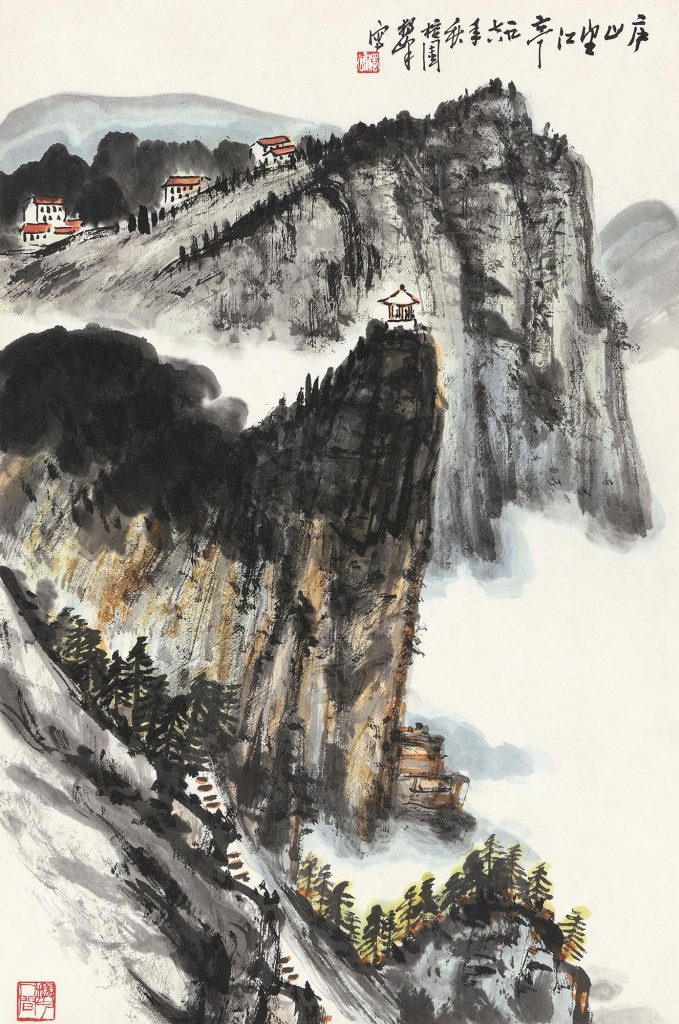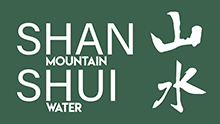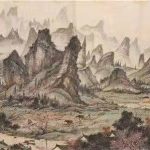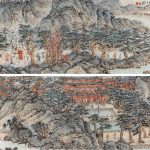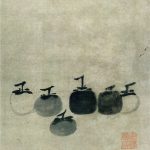An Example of Regional Characteristics and Plein-air Painting: Huang Dufeng 黄独峰’s Artistic Features and Achievements in Mountain and Water Painting
By; Liu Qimou 刘启谋
Translated by; Ning Lizheng 宁立正, Zhang Xiaoyu 张小雨, Zhou Zhi 周智
Guangxi 广西 is rich in natural and cultural landscapes and colorful ethnic customs, especially in Guilin 桂林, which has the most beautiful landscapes and distinctive regional characteristics. Soaring hills in various shapes and sizes filled with dozens of caves, and the Lijiang River 漓江, winding and as clear as a mirror. The caves, deep and quiet, hold miracle sceneries. Many strange rocks lie in the caves, whose great beauty is shaped by nature. Thus, these four features: the green hills, the clean water, the miracle caves and the beautiful rocks are Guilin’s Four Uniques. Guilin not only has beautiful landscapes, but it also has a very long history. According to the findings and research of the relics of Baojiyan 宝积岩 and Zhenpiyan 甑皮岩 caves in the urban area, it was discovered that the Zhenpiyan people were living in a Matriarchal society which dated back ten thousand years. During the Xia, Shang and Zhou periods 夏商周时期, Guilin became the residence of the Baiyue 百越 people. The Emperor Qin Shihuang 秦始皇 set three provinces there, namely Guilin, Xiang and Nanhai, which became the origin of the present name of Guilin. The great regional culture contributes to the unique aesthetic characteristics and aesthetic consciousness of this place, which provides abundant materials for the creation of art in Guangxi.
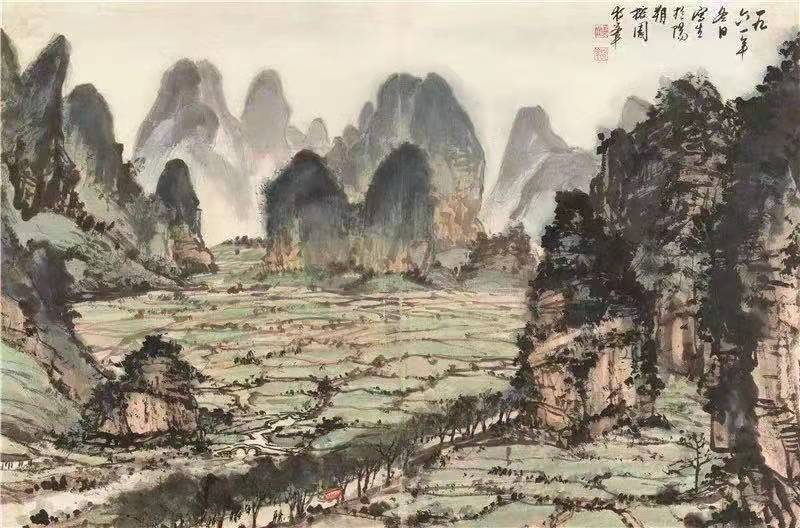
In Chinese history, many painters have painted works of Guilin landscapes, artists such as Shi Tao 石涛 during the 17th century, and Qi Baishi 齐白石 , Huang Binhong 黄宾虹, Xu Beihong 徐悲鸿 and Li Keran 李可染 during the 20th century. However, when it comes to the influence on later generations, we must mention the famous national painter — Huang Dufeng 黄独峰, one of the founders of Guangxi School of Painting.
Huang Dufeng was engaged in various arts, and his Flower-and-Bird paintings 花鸟画 earned him national and international fame. His Mountain-and-Water paintings also have special value to Chinese art history. In his early years, he began painting in Chunshui Painting Academy 春睡画院 and became a disciple of Gao Jianfu 高剑父, a master of the Lingnan Painting School 岭南画派. Afterwards, in 1950 in Hong Kong, he became a disciple of Zhang Daqian 张大千 and took part in Dafengtang Painting Academy 大风堂, concentrating on the study of traditional techniques of Mountain-and-Water painting. After a lot of hard work at Linnan School of Painting and at Dafengtang Painting Academy, there were soon two peak periods of his Mountain-and-Water painting creations. The first peak period was in the 1960s, The Plein-air Paintings of Guilin Landscape《桂林山水写生》 series are a representative of his plein-air paintings. His works of this period are dark, splendid, and impressive, with a natural feeling of landscape. The second peak period of his art was from the mid-1970s to the early 1980s, represented by the work A hundred Miles of Lijiang River《漓江百里图》. His works of this time are heroically bold and unrestrained, brief but forcefully vigorous, depicting the unique features of the landscape in Guangxi, especially in Guilin. All works show Huang Dufeng’s artistic achievements in Mountain-and-Water painting. Take The Plein-air Paintings of Guilin Landscape series for an example, the artistic characteristics of Huang Dufeng’s mountain-and-water painting are analyzed here. Guilin’s landscape is in a unique karst landform, with a beautiful hill shape. The peaks independently rise from the ground and are rarely connected to one another. Many peaks are wrapped with thick vegetation and rock structures, only highlighting the cliffs, which increases the difficulty in art technique processing. Moreover, most hills in Guilin are small and steep, with no way of climbing. Different from other huge mountains, visitors can’t observe the trend and structure of the hill from different positions, which means inconvenience organizing the composition and creating the painting. Viewers are generally on the horizon, so it is hard to enjoy the height of the hill, or get into the artistic conception of dwarfing all other hills around 一览众山小. A clean river with green hills on both sides is actually a horizontal line with a few vertical lines. Without all these, it can not be called the name of “Lijiang River”. Therefore, it is not easy to express the great Lijiang River landscape. There were many paintings created according to the Lijiang River landscape in Guilin in past dynasties, amongst which many of them were created by famous painters, but they were works with similar shape and spirit of scenery, exquisite in the use of brush and ink. An unworldly artistic conception is rare. It is always a challenge in the field of Chinese mountain-and-water painting to show its delicacy and splendid views of the Lijiang River located in Guilin rather than losing its aesthetic value as an art work. Huang Dufeng, who had studied the landscape of Guilin in depth, certainly understood the difficulties. Thus he sketched the scenery of the Lijiang River area of Guilin all year round. After years of experience and practice, he achieved a whole set of ink language to express the landscape of Lijiang River in Guilin, and accumulated abundant experiences of creation.
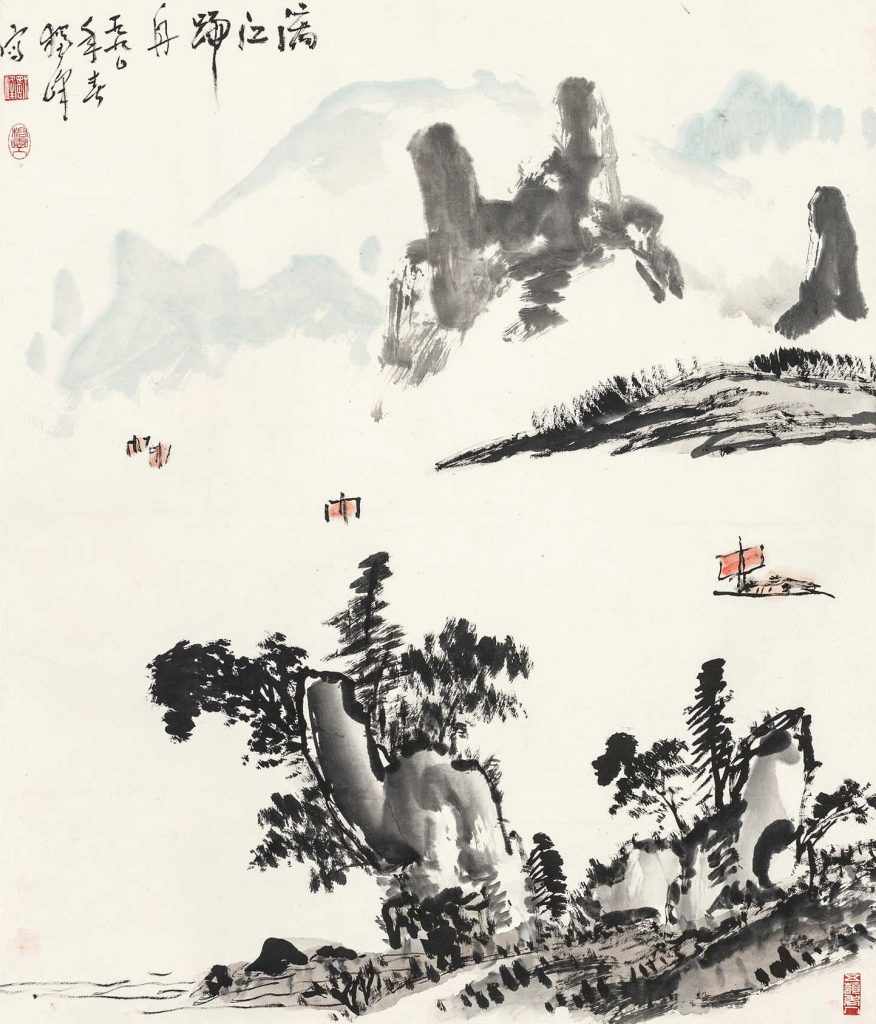
Works of The Plein-air Paintings of Guilin Landscape series were painted in the 1960s. These works have shown the beautiful scenery of the area of Lijiang River in Guilin, with small sizes, well-organized compositions and clear themes. The Lijiang River landscape is gentle and tranquil, and it is not easy to make a visual impact completely with traditional methods of composition. Thus, Huang Dufeng took advantage of the trend of hills and the route of sailing boats to build up the atmosphere. He employed short lines and dry brushes to paint disordered trees at the fore part, which could enrich the variation of lines. As for the main part of the painting, he implied wet long texturing to paint the hill rocks concisely. And for the sand, land and clouds in the distance, the color of ink differs from heavy to light, the brushes from dry to wet, gradually pushing to the depth of the painting, which shows a strong sense of space. Ochre and flower blue, with a little mineral blue, are the main colors to show the moist and pretty spirit of Lijiang River, calm and clean. Fresh and unique brush and ink, dainty composition, elegant colors form the feature of an imposing manner. Those characteristics, unrestrained and introverted, ethereal and natural, all reflect Huang Dufeng’s superb skills in controlling the brushes and ink, and the composition of the painting.
Lijiang River is in the south of China, with the features of tropical weather, the karst rock landform and elegant landscape. All these require the applications of changeable brushes and ink for dry and wet, tranquil, light and elegant. Thus, it is improper to employ gaudy and showy colors. Mainly with alienated hills, clouds and clear and elegant colors. This series of works depict the miracle scenery along the banks of Lijiang River. With a few simple brushes, the beautiful scenery of Lijiang River is painted on Xuan paper 宣纸, ethereal and pure .
Although works of The Plein-air Paintings of Guilin Landscape series are plein-air paintings, the painting atmosphere is ancient and elegant, which seems to have inherited the interest of Shi Tao’s brush technique. Huang Dufeng had studied under Zhang Daqian, and such experiences resulted in his deep understanding of the traditional brush and ink, which is simple and elegant in the use of ink and color. He also learned from the masters of Lingnan Painting School. Thus, he could well combine plein-air painting with tradition. He obeyed the laws of tradition and nature, but neither of them could limit him. His painting style is unique, elegant and ethereal. Huang Dufeng reproduced the scenery of Lijiang River in Guilin in the way of plein-air painting and created a wonderland of brush and ink, which reflects his pursuit of plein-air painting and the artistic realm of forgetting both nature and his mind. These masterpieces show the way of a painter to make perfect combinations of regional characteristics and art forms in his plein-air creations.
Huang Dufeng learned to paint mountain-and-water painting from the traditions, but achieved more than traditions; his mountain-and-water painting comes from life, and becomes higher than life.
Hundred-Miles-of-Lijiang-Riverpartial-纸本设色-1976年.jpg)
Huang Dufeng once described his pursuit of mountain-and-water painting in this way, “Now I focus on realistic depiction. In the future I hope I can create a painting at will with some detailed additions, and also I hope that I could speak for the landscape. And in the end the landscape could stand for me, as I would for the landscape”. It can be seen that Huang Dufeng’s pursuit of realistic depiction is the harmony between man and nature, and achieving the artistic realm of forgetting both the nature and his mind 物我两忘. As for “speaking for the landscape”, it is the painter’s pursuit of the natural atmosphere of mountain-and-water painting. The Plein-air Paintings of Guilin Landscape is not only the process of Huang Dufeng’s creation in mountain-and-water painting, but also the process of revealing his true personal feelings. His appreciation and love for the great landscape, as well as his feelings about the infinite scenery, are all written on Xuan paper with a brush. These true artistic feelings cannot be achieved by “painting behind closed doors”. This makes Huang Dufeng’s works an artistic appeal from the heart, which is natural because of his sincerity.
Huang Dufeng used the traditional technique flexibly in the plein-air creation, in his numerous plein-air works, and not a single traditional painting stylized expression could be seen — no program stack consisting of trees and stones, no fixed composition, also no invariable rock texturing method to replace various landscape from the east, the west, the north to the south. His painting techniques are not directly “copied” from the traditional technique library, but flexibly applied according to different objects in the objective world in the plein-air painting. In Huang Dufeng’s view, the painting technique is only a means, not a purpose, and a carrier to express the objective world. Painters should take advantage of the techniques as their tools without being limited by them.
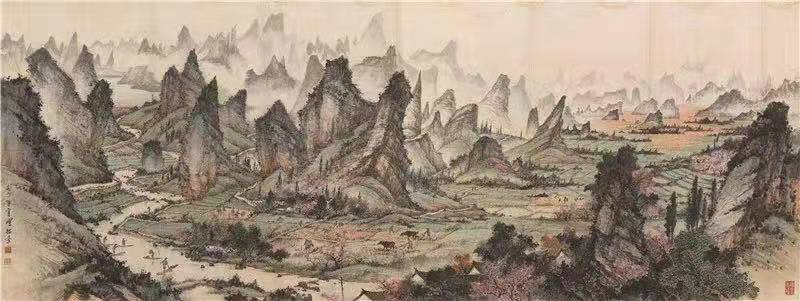
In his early years, Huang Dufeng was fond of paintings and theories of the Song Dynasty. “He has a profound study of modern Song school paintings. ” Fan Kuan 范宽 proposed, “Instead of learning from the teacher, we should learn from the nature. Living in Taihua 太华 in central south of China and painting landscapes, we can form our own painting style from this life. Jing Hao 荆浩 put forward, “Honggu 洪谷 is inside Taihang Mount 太行山 …… Due to the abundance of its diversities, I have been there many times to appreciate it, and tomorrow I’ll try to paint to reproduce it, and after tens of thousands of copies later, I’m sure to reproduce the verve of it.” Huang Dufeng’s view of plein-air painting collaborates with it. Huang Dufeng studied the theory and techniques of the Song dynasty, but he did not rigidly copy them in the plein-air painting, but only took their spirit into use. For example, The river mouth painting
《江口写生》, the beach stones by the river are messy and deformed after being washed by water. Huang Dufeng first outlined the shape of the beach stones with the Zhongfeng approach of the brush 中锋用笔, and then employed Tian 提按, Diantiao 点挑 to show the texture of the stones like being chiseled by the axe, which is precisely based on the traditional brushwork flexibly.
Huang Dufeng has distilled a practical painting style from the traditional painting and combined it well with the plein-air painting. This kind of style is mainly formed by adding details to a painting at will, especially suitable for the depiction of the southern scenes, such as dense weeds, jungles, low hills, emerald paddy fields, lush bamboo forests, etc. He employed splash-ink 泼墨 and break ink 破墨 to add details to a painting of the copses and weeds on the hill, making blackish color to be a comprehensive virtual-real combination, thus expressing the lushness of the vegetation. Sometimes he employed mineral green to paint grass, slopes and hills, and used the ink stick to paint distant hills or slopes. The ink color is various and it may be deep and light. Then he added the stone pattern outlined in the ink block with Zhongfeng brush, combining the line and surface, so that he could hide the bone brush on the surface. After numerous plein-air practices and continuous experiences, Huang Dufeng composed a unique style of plein-air mountain-and-water painting of his own.
While painting plein-air, Huang Dufeng was not limited by the use of colors, but entirely based on the environment. Colors, like ochre, phthalocyanine pigments, cinnabar, emerald, mineral green, eosine lake, gamboge for painting, and azurite, would be used in the painting. He also uses azurite to paint the ocean water, uses gamboge for painting paddy fields, and uses cinnabar to paint skies, etc. He tried his efforts to depict the colorful world with realistic painting style according to what he had seen, which also expanded the range of colors used in mountain-and-water painting and increased the expressive power of colors in mountain-and-water painting.
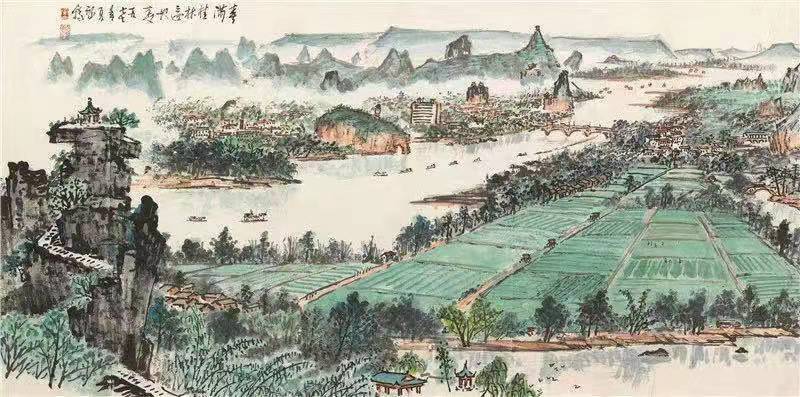
Huang Dufeng’s mountain-and-water paintings are from the traditional style, but keeping a very distance from the traditional mountain-and-water painting. His mountain-and-water paintings are also full of a strong modern atmosphere and vitality. In his paintings, every blade of grass, every tree, every house and ridge, the flowing water and sandy beaches are all vivid, without the desolate landscape realm of the ancient paintings where the hermits lived.
What is valuable about his paintings is that they are away from the traditional ancient painting style, and the traditional techniques have been improved and truly integrated into the hills and rivers that the painter feels. The painter employed ink to depict the object, rather than using the programs of painting style to apply to nature. His works reveal a natural beauty, without any pretensions. And he can calmly and slowly create a refreshing fragrance. His art of mountain-and-water painting is successful, and his success is in accepting the excellent tradition, rather than being bound by it.
Huang Dufeng advocated that art creation in Guangxi should explore the local regional characteristics of itself to express the regional culture and create an aesthetic character and artistic personality unique to Guangxi. “Guangxi is pretty scenic with a unique geographical environment, so we should create a Guangxi style!”, “Guilin has a lot of hieroglyphic hills, with all kinds of shapes, and that’s our advantage.” Since Huang Dufeng truly realized the preciousness of Guangxi’s landscape resources, he had been painting plein-air all over Guangxi many times, including Sanjiang 三江, Rongshui 融水, Longsheng 龙胜, Guiping 桂平, Qinzhou 钦州, Hechi 河池, Beibuwan 北部湾, etc, and especially Guilin many times. Huang Dufeng included the unique objects of Guangxi into his paintings during plein-air painting, such as plantain, bamboo grove, cabin, village and terrace. These images show the local characteristics of Guangxi and provide many references for the development of painting for later generations. A large number of plein-air paintings of the Li River landscape by Huang Dufeng are extremely precious. This has accumulated rich resources and cultural heritage for the formation and development of Lijiang Painting School and made great contributions to the development of painting in Guangxi.
Take the Plein-air Painting in Xingping 《兴坪写生》 for example. It was painted in 1975, depicting the beautiful scenery of Xingping in Yangshuo 阳朔 in a realistic way. The landscape of Yangshuo is fresh and beautiful, with exquisite hill shapes. Painters should not use too many lines in their works, otherwise, the sense of moistness of the Guilin landscape could not spring up. The ink should not be too heavy, or it will lose the characteristics of the clear Guilin’s landscape. The shape of the hill should not be too sharp, or it would look too elegant and graceful. Huang Dufeng has well made the combination of them. With a few lines in his paintings, he slightly outlined the shape of the hills. And he depicted the moist landscape with ink blocks and colors, encompassing the smoky atmosphere and the divine charm of Lijiang River. He realistically dotted the hills with thick ink based on the shape of the hills in Yangshuo, allowing different ink colors to be superimposed to create rich variations to show the dense vegetation on the hills.
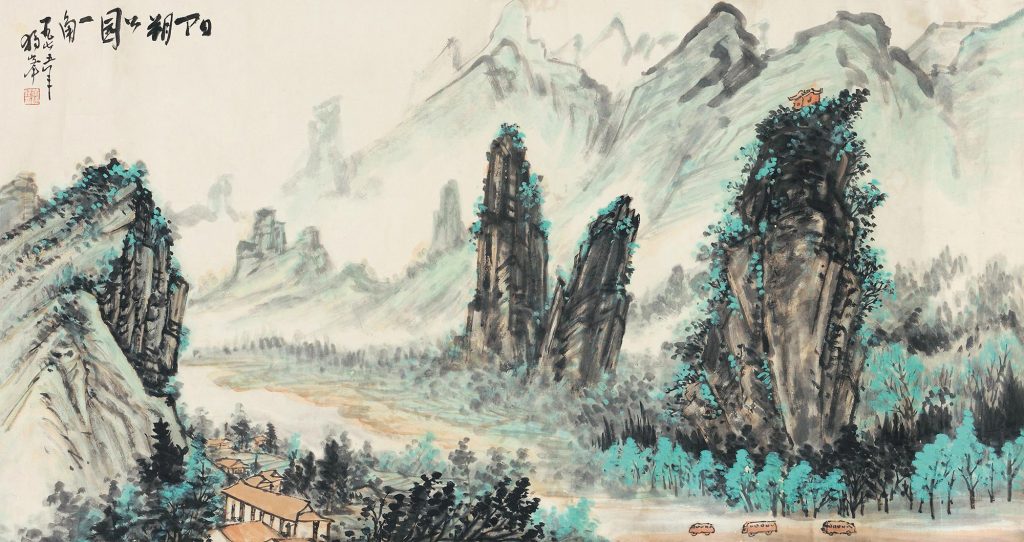
The light ink of the distant hills is dyed to nothingness, and the ink is clear and transparent, forming a strong contrast with the heavy ink in the foreground, and this effect of thickness and lightness produces a feeling of misty smoke and clouds. For the plein-air paintings, Huang Dufeng discovered the landscape resources of Guangxi and enriched the ways of Guangxi mountain-and-water painting.
Huang Dufeng always insisted on inheriting and carrying forward the traditional spirit of national culture, emphasizing the combination of Chinese and Western painting languages. His landscape works are mainly plein-air paintings. He advocated to perceive, think, and explore the wonders of nature with our own mind, keeping on exploring our regional characteristics to develop a new way of mountain-and-water painting. The method of going into the deeper life, insisting on plein-air painting and creating works in front of the scenes has become a significant feature for the teaching of art majors in Guangxi Arts University and has also become the main means to paint for Lijiang Painting School today. As an excellent art educator, most of his students have now become the backbone of Guangxi’s painting circle and have made positive contributions to the development of Guangxi arts.
At present, as there aren’t many domestic and international researches on Huang Dufeng, it is necessary for us to reinterpret, re-understand and reposition this master. Therefore, researching Huang Dufeng’s masterpieces in mountain-and-water painting by combining Guangxi’s regional culture and filling this theoretical gap will have positive significance to the development of Guangxi art career and the Chinese art career, which will have a far-reaching impact on the development of “Lijiang Painting School”.
Read the full magazine
